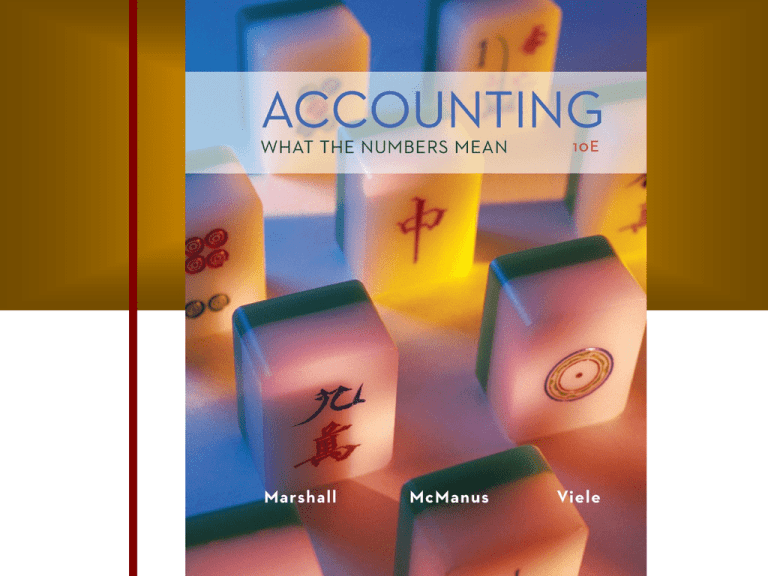
© 2008 The McGraw-Hill Companies, Inc., All Rights Reserved.
McGraw-Hill/Irwin
Copyright © 2014 by The McGraw-Hill Companies, Inc. All rights reserved.
Chapter 12
Managerial Accounting and Cost–
Volume–Profit Relationships
PowerPoint Authors:
Susan Coomer Galbreath, Ph.D., CPA
Charles W. Caldwell, D.B.A., CMA
Jon A. Booker, Ph.D., CPA, CIA
Cynthia J. Rooney, Ph.D., CPA
McGraw-Hill/Irwin
Copyright © 2014 by The McGraw-Hill Companies, Inc. All rights reserved.
1-3
LO1
The Management Process
McGraw-Hill/Irwin
12-3
© 2008 The McGraw-Hill Companies, Inc., All Rights Reserved.
1-4
LO2
Managerial Accounting
versus Financial Accounting
Managerial accounting
supports the internal
planning (future-oriented)
decisions made by
management.
McGraw-Hill/Irwin
Financial accounting has
more of a scorekeeping,
historical orientation
that provides information
to owners and others
outside the organization.
12-4
© 2008 The McGraw-Hill Companies, Inc., All Rights Reserved.
1-5
LO2
Managerial Accounting
versus Financial Accounting
Managerial
Accounting
Financial
Accounting
Internal to managers
External to investors
and creditors
Present and Future
Historical perspective
Micro - Individual units
of organization
Macro - Entire organization
Reporting frequency
and promptness
Frequent and timely one day after period ends
Monthly - a week or
more after period ends
Degree of precision
Relevance more important
than reliability
High accuracy desired reliability very important
None imposed
Must follow GAAP
and prescribed formats
Service perspective
Time Frame
Breadth of concern
Reporting standards
McGraw-Hill/Irwin
12-5
© 2008 The McGraw-Hill Companies, Inc., All Rights Reserved.
1-6
LO3
Relationship of Total Cost
to Volume of Activity
How a cost will react to
changes in the level of
business activity.
– Total variable costs
change when activity
changes.
– Total fixed costs
remain unchanged
when activity changes.
McGraw-Hill/Irwin
12-6
© 2008 The McGraw-Hill Companies, Inc., All Rights Reserved.
1-7
LO4
McGraw-Hill/Irwin
Cost Behavior Patterns
12-7
© 2008 The McGraw-Hill Companies, Inc., All Rights Reserved.
1-8
LO5
Cost Behavior Patterns
Great care must be taken with the use of fixed cost per unit data
because any change in the volume of activity will change the per unit
cost. As a general rule, do not unitize fixed expenses because they do
not behave on a per unit basis! Sometimes fixed costs must be
unitized, as in the development of a predetermined overhead
application rate. It is also important to recognize that the relevant
range is often quite wide, and significant increases in activity can be
achieved without increasing fixed costs.
McGraw-Hill/Irwin
12-8
© 2008 The McGraw-Hill Companies, Inc., All Rights Reserved.
1-9
LO5
Relationship of Total Cost
to Volume of Activity
Total Cost
Economist’s
Curvilinear
Cost Function
Relevant
Range
A straight line
closely
approximates
a curvilinear
variable cost
line within the
relevant
range.
Accountant’s Straight-Line
Approximation (constant
unit variable cost)
Activity
McGraw-Hill/Irwin
12-9
© 2008 The McGraw-Hill Companies, Inc., All Rights Reserved.
1-10
LO5
Relationship of Total Cost
to Volume of Activity
Typical variable costs
• Raw materials
• Direct labor
• Factory utilities
• Sales commissions
• Shipping costs
McGraw-Hill/Irwin
Typical fixed costs
• Real estate taxes
• Insurance
• Supervisory salaries
• Depreciation
• Advertising
12-10
© 2008 The McGraw-Hill Companies, Inc., All Rights Reserved.
1-11
LO6
Estimating Cost Behavior
Patterns
The high-low method is
used to determine the fixed
and variable components
of a semivariable cost.
McGraw-Hill/Irwin
12-11
© 2008 The McGraw-Hill Companies, Inc., All Rights Reserved.
1-12
LO7
The Contribution Margin
Format
Used primarily for
external reporting.
McGraw-Hill/Irwin
Used primarily by
management.
Both formats report the ©same
operating
income!
12-12
2008 The McGraw-Hill
Companies,
Inc., All Rights Reserved.
1-13
LO8
The Contribution Margin
The contribution margin format derives its name from the
difference between revenues and variable expenses.
Cruiser, Inc.
Contribution Margin Income Statement
For the Month of June
Revenues
$ 100,000
Variable expenses
50,000
Contribution margin
50,000
Fixed expenses
40,000
Operating income
$ 10,000
McGraw-Hill/Irwin
12-13
© 2008 The McGraw-Hill Companies, Inc., All Rights Reserved.
1-14
L O 11
McGraw-Hill/Irwin
Break-Even Graph
12-14
© 2008 The McGraw-Hill Companies, Inc., All Rights Reserved.
1-15
L O 12
Operating Leverage
When an entity’s revenues change because the volume of activity
changes, variable expenses and contribution margin will change
proportionately. But the presence of fixed expenses, which do not change
as the volume of activity changes, means that operating income will
change proportionately more than the change in revenues. This
magnification of the effect on operating income resulting from a change in
revenue is called “operating leverage.” The higher a firm’s contribution
margin ratio, the greater its operating leverage.
McGraw-Hill/Irwin
12-15
© 2008 The McGraw-Hill Companies, Inc., All Rights Reserved.
1-16
End of Chapter 12
McGraw-Hill/Irwin
12-16
© 2008 The McGraw-Hill Companies, Inc., All Rights Reserved.





